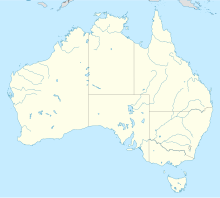Break of the Briseis dam
Coordinates: 41 ° 10 ′ 30 ″ S , 147 ° 49 ′ 25 ″ E
The Briseis dam (English: Briseis dam , also: Cascade dam ) on Tasmania in Australia failed on April 4, 1929 after heavy rainfall. The resulting tidal wave devastated the city of Derby , killing 14 (or 11) people.
The dam
The small dam had been built just a few years earlier on the Cascade River in the northeast of the island of Tasmania to supply the Briseis Tin Mine with water. The dam had a 27 m high earth dam . The Briseis mine was one of the largest tin mines in the world, producing 120 tons per month. It was named after the horse that won the Melbourne Cup in 1876. The name Briseis is a female figure from Greek mythology , from Homer's Iliad .
The storm
In this area there is a climate with much less rain than in the west of the island. However, in short periods it can rain very heavily for days and cause flooding. The worst of these floods ever recorded occurred in April 1929. The storm lasted from Wednesday April 3 to Saturday April 6, 1929. In two areas, in the north-eastern highlands and south of Burnie and Ulverstone , 500 mm of precipitation fell in three days. At Mathinna , 337 mm was recorded within 24 hours.
The tidal wave
The dam broke on April 4th in the afternoon. A tidal wave of up to 30 m high was created, which raced through the gorge of the Cascade River to the city of Derby, three miles below. In a report, the amount of water is given as 3500 cubic meters, but this cannot be correct because that would be too little by at least a factor of 1000. On the other hand, 3500 m³ / s (cubic meters per second) would be too much. The tidal wave carried thousands of tons of trees, boulders, rocks and rubble with it.
The amount of water was so great that the Ringarooma River reversed its direction to Branxholm , about five miles upstream. 14 people drowned when the dam broke . Another eight people died when a truck fell off a bridge into a river in Gawler , Ulverstone. At Avoca , the level of the river rose 17 m above normal in summer.
Longford and the low-lying areas of Launceston were flooded and 4,500 people were left homeless. The Duck Reach power plant and the Cataract Gorge bridge were destroyed. Many other buildings, roads and bridges were also destroyed. However, this damage must not all have been caused by the dam breach, but also by the general flood.
After the accident, the mine was closed and only reopened in 1934. It never again reached the production volume as at the end of the 19th century. In 1948 mining was given up.
See also
literature
- John Beswick: Brother's Home: The Story of Derby Tasmania . Gravelly Beach / Beswick 2003. ISBN 0975121308 .
